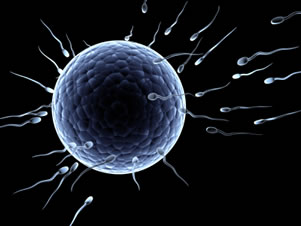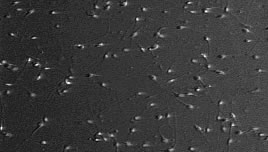Male Infertility Testing
The Fertility Institute of Hawaii in Honolulu is one of only a few centers in Hawaii that have the capability to perform a comprehensive male infertility evaluation.
The sperm’s ability to fertilize an egg

Several factors determine whether a man’s sperm can fertilize an egg. Semen quality and quantity may affect the ability of sperm to fertilize the egg successfully. The ability of sperm to move, referred to as motility, appears to be one of the most important factors in determining the fertilizing capability of sperm. Even with a low sperm count, men with highly motile sperm may still be fertile. The shape of the sperm, referred to as morphology, may also affect its ability to fertilize an egg. In addition, the sperm must live long enough to reach the egg, a characteristic know as viability.
Semen Analysis Testing: a semen analysis is needed to determine how the sperm is to be delivered to the egg. Options for sperm delivery include appropriately timed intercourse, intrauterine insemination, in vitro fertilization (IVF) and IVF with ICSI (intracytoplasmic sperm injection).
Infectious Disease Screening: (HIV, syphilis, hepatitis) With these diseases you may be infected, but asymptomatic, for long periods of time. All of these can be passed along through the semen. The chance of transmission after sperm washing for IUI or IVF is very low.
Genetic Carrier Screening: ACOG recommends that DNA screening for cystic fibrosis and other genetic diseases be available to all couples seeking preconception or prenatal care.
- Karyotype: This is a test that evaluates the chromosomes. In some conditions, the rate of chromosomal abnormalities is increased. Finding a chromosomal abnormality would mean that the sperm of that individual would not be used.
- Y-Deletions Testing: In some men with very low sperm counts, the problem is due to structural abnormalities in the segment of the Y-chromosome that controls sperm development. Pregnancy can occur (via IVF with ICSI), but these abnormalities can be passed on to any male children.
- Cystic Fibrosis: ACOG recommended that ob-gyns make DNA screening for cystic fibrosis available to all couples seeking preconception or prenatal care- not just those with a personal family history of carrying the CF gene, as previously recommended.
Semen Analysis
Semen Analysis Testing: Infertility may be caused by many things. Most studies suggest that sperm abnormalities with the male account for about 40% of all infertility, while couples with problems with both partners account for another 20%. The basic test to evaluate fertility in the male is the Semen Analysis.
The purpose of the semen analysis is to:
- Evaluate the seminal plasma for abnormalities in its density, volume and biochemical characteristics
- Look at the sperm under the microscope for abnormalities in number, shape and movement. Based on the results of the semen analysis, recommendations on further evaluation and/or therapy may be made.
How to Schedule a Semen Analysis
- Call the office (808.545.2800) to schedule the semen analysis.
- An appointment is absolutely necessary so that the specimen may be evaluated in an appropriate and timely manner.
- If you are unable to make the appointment, please call the office to cancel, so that another patient may be scheduled.
- All specimens should be produced by masturbation. Never use over-the-counter condoms meant for contraception: they are toxic to sperm. If collection is by other than masturbation, you will be given a special sterile condom by our office, along with special directions on how to use it.
Specimen Collection Instructions
- Refrain from any sexual activity that would result in ejaculation of semen for at least 2 days, but not longer than 7 days prior to the specimen collection.
- The specimen will be collected by masturbation in a private room in our office or at home.
- You will be provided a sterile container from the laboratory
- No lubricants (except mineral oil) are to be used because they are bad for the sperm.
- Wash your hands prior to producing the specimen to minimize the chances for contamination.
- Remove the lid from the container.
- Produce the specimen.
- Avoid touching the inside of the container with your fingers or penis.
- Replace the lid immediately after completing the collection.
- Interrupted intercourse is not an acceptable method of collection for infertility purposes.
- Please deliver your sample directly by handing it to a lab representative.
Home Collections
- Obtain a sterile collection container from the office.
- This specimen should also be produced by masturbation.
- Follow the collection instructions above.
- Make sure the specimen is properly labeled.
- The specimen should be delivered to the laboratory within one hour of ejaculation.
- Care should be taken to maintain the specimen at body temperature (carried upright in an inside pocket, close to the body).
- DO NOT refrigerate the specimen or place it in hot water.
- If there are problems with the collection, please let the lab personnel know, as this will aid in interpretation of the specimen.
Interpreting the Results of the Semen Analysis
The semen analysis results are interpreted within the context of the couple’s entire evaluation to provide the most efficient and effective means of sperm delivery for a given situation.
Semen Analysis Normal Values

| Volume: 2.0-5.0 cc |
If the volume is too small, there may not be enough to get to the cervix, if there is too much, it may dilute the sperm. |
| Concentration: >20 million/cc |
Sperm concentrations may vary widely from within the same individual. Among the factors that can effect the concentration include frequency of ejaculation, environmental factors, surgery/trauma, heat and ingestables (drugs, alcohol, recreational drugs). About 20-25% of fertile men actually have counts below 20 million. |
| Motility: 50% |
This is the proportion of sperm that are swimming. They may swim very fast, moderately fast or slow. The sperm may also wiggle in place or not move at all. |
| Morphology: | The overall appearance of the sperm. The normal range of morphology depends on the laboratory analysis. Please consult with your physician concerning the result. |
| White Blood Cells: < 1 million/cc |
The presence of WBC suggest that an inflammatory process is ongoing in the male reproductive tract. They can secrete factors that inhibit a sperm’s ability to move and fertilize an egg. White blood cells may be markers for infection, which can be treated with antibiotics. |
Negative Environmental Factors and Sperm Function
However, long-term use can result in permanent impairment. A number of drugs also contribute to problems with sperm. These include calcium channel blockers (anti-hypertensives, see list below), cimetidine, spironolactone, nitrofurantoin, sulfasalazine, erythromycin, tetracycline, and anabolic steroids. Other drugs that can be problematic include chromium picolinate, DHEA, androstenedione, colchicines, and methotrexate. Calcium channel blockers are particularly important to know about, as the sperm can appear normal, but not be able to fertilize an egg because of changes induced in the sperm cell membrane by the medicine.
Chemical exposures by other means can affect sperm production/function. These include heavy metals (lead, mercury, boron), organic solvents (acetone, ethylene glycol, benzene, toluene, etc) and pesticides (dibromochloropropane, ethylene dibromide, carbaryl, chordecone). Other physical factors that have been associated with sperm abnormalities or reduced fertility include, heat, vibration (truck driving, bike riding), electromagnetic fields and microwave radiation. Therapeutic interventions might include the use of artificial insemination, donor insemination, in vitro fertilization or intracytoplasmic sperm injection with IVF.
Calcium Channel Blockers
If you are on one of these drugs, it is important to tell your doctor and nurse. Calcium channel blockers can alter the sperm cell membrane so that they cannot fertilize an egg, despite being normal in every other way. If you are not sure about one of your medications, please ask your doctor or nurse.
| Generic Name | Brand Name |
| Amlodipine | Norvasc |
| Bepridil | Vascor |
| Diltiazem | Cardizem, Tiazac |
| Felodipine | Plendil |
| Nicardipine | Cardene |
| Nifedipine | Adalat, Procardia |
| Nimodipine | Nimotop |
| Nisoldipine | Sular |
| Verapamil | Calan, Covera, Isoptin, Verelan |